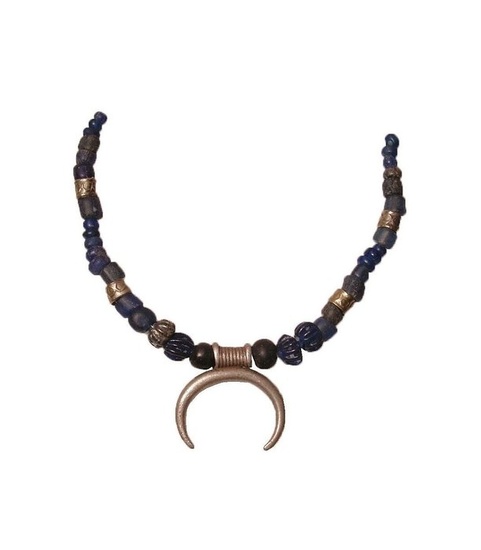Ancient Roman Roman Lunula silver pendant with silver beads and blue melon beads, BEST OF Necklace
Collection dissolution
There is one for sale
beautiful Lunula jewelry pendant made of silver
from the Roman era with ancient ones
Jewelry beads made of silver and sea-blue antique glass.
Age: approx. 2nd century BC - 4th century AD
Size: total length 16. 1 cm, length of the lunula pendant 2. 7 cm and total weight 12. 5 g.
Condition/shape: Very well preserved, beautifully crafted lunula pendant with numerous glass beads and silver beads in museum-like condition. (without chain clasp)
The shape of the pendant is interesting and is in excellent condition. The beads are made of sea blue antique glass, including four melon-shaped beads. The jewelry band is also decorated with four silver beads with circular ornaments.
The Lunula pendant was an important piece of jewelry in Roman antiquity. The lunula is a special form of pendant shaped like a small crescent moon. It was often made from precious materials such as gold or silver. However, the exact meaning of the lunula in ancient Roman times may vary, as jewelry often had multiple meanings and uses.
Here are some of the possible meanings and uses of the lunula in ancient Roman times:
Amulet: The Lunula was often worn as a protective amulet to protect against evil forces or the evil eye. In many cultures, crescents and crescent moons were considered good luck charms.
Religious Significance: The shape of the lunula was reminiscent of the moon, which played an important role in Roman mythology and religion. Therefore it could also have had religious significance and been associated with lunar deities.
Fashion and beauty: Like many pieces of jewelry in antiquity, the lunula also served to emphasize the beauty and social status of the wearer. Richly decorated lunulae were often a sign of wealth and social position.
Symbol of Femininity: The Lunula could also be interpreted as a symbol of femininity and the goddess Luna, the Roman moon goddess.
It is important to note that the meaning of jewelry in ancient times could vary from time to time and from culture to culture. Therefore, the meaning of the lunula may have been slightly different in different Roman social classes or in different historical periods.
Origin: From a more than 40-year-old antique collection, estate from an old German collection, as well as a northern European estate, acquired in the early 1980s.
The artifact was part of a private collection.
Protection of cultural assets:
All artifacts we offer come from a private collection,
The acquisition and export of the artifacts were not subject to any legal regulations at the time.
This also applies to finds from German federal states - where sales are still legal today.
Ownership is therefore legal – all legal regulations are adhered to.
View it on
Estimate
Time, Location
Auction House
Collection dissolution
There is one for sale
beautiful Lunula jewelry pendant made of silver
from the Roman era with ancient ones
Jewelry beads made of silver and sea-blue antique glass.
Age: approx. 2nd century BC - 4th century AD
Size: total length 16. 1 cm, length of the lunula pendant 2. 7 cm and total weight 12. 5 g.
Condition/shape: Very well preserved, beautifully crafted lunula pendant with numerous glass beads and silver beads in museum-like condition. (without chain clasp)
The shape of the pendant is interesting and is in excellent condition. The beads are made of sea blue antique glass, including four melon-shaped beads. The jewelry band is also decorated with four silver beads with circular ornaments.
The Lunula pendant was an important piece of jewelry in Roman antiquity. The lunula is a special form of pendant shaped like a small crescent moon. It was often made from precious materials such as gold or silver. However, the exact meaning of the lunula in ancient Roman times may vary, as jewelry often had multiple meanings and uses.
Here are some of the possible meanings and uses of the lunula in ancient Roman times:
Amulet: The Lunula was often worn as a protective amulet to protect against evil forces or the evil eye. In many cultures, crescents and crescent moons were considered good luck charms.
Religious Significance: The shape of the lunula was reminiscent of the moon, which played an important role in Roman mythology and religion. Therefore it could also have had religious significance and been associated with lunar deities.
Fashion and beauty: Like many pieces of jewelry in antiquity, the lunula also served to emphasize the beauty and social status of the wearer. Richly decorated lunulae were often a sign of wealth and social position.
Symbol of Femininity: The Lunula could also be interpreted as a symbol of femininity and the goddess Luna, the Roman moon goddess.
It is important to note that the meaning of jewelry in ancient times could vary from time to time and from culture to culture. Therefore, the meaning of the lunula may have been slightly different in different Roman social classes or in different historical periods.
Origin: From a more than 40-year-old antique collection, estate from an old German collection, as well as a northern European estate, acquired in the early 1980s.
The artifact was part of a private collection.
Protection of cultural assets:
All artifacts we offer come from a private collection,
The acquisition and export of the artifacts were not subject to any legal regulations at the time.
This also applies to finds from German federal states - where sales are still legal today.
Ownership is therefore legal – all legal regulations are adhered to.



